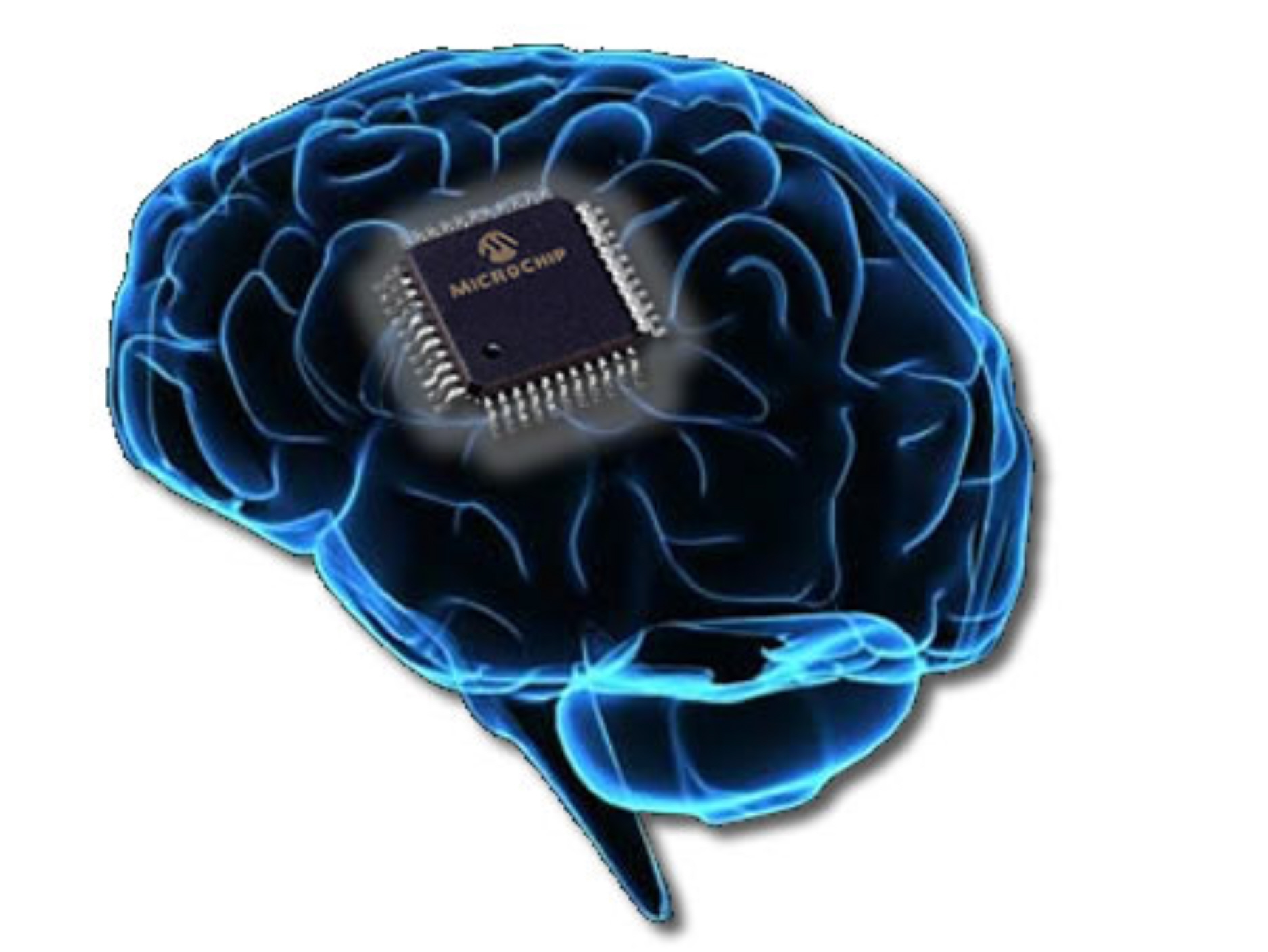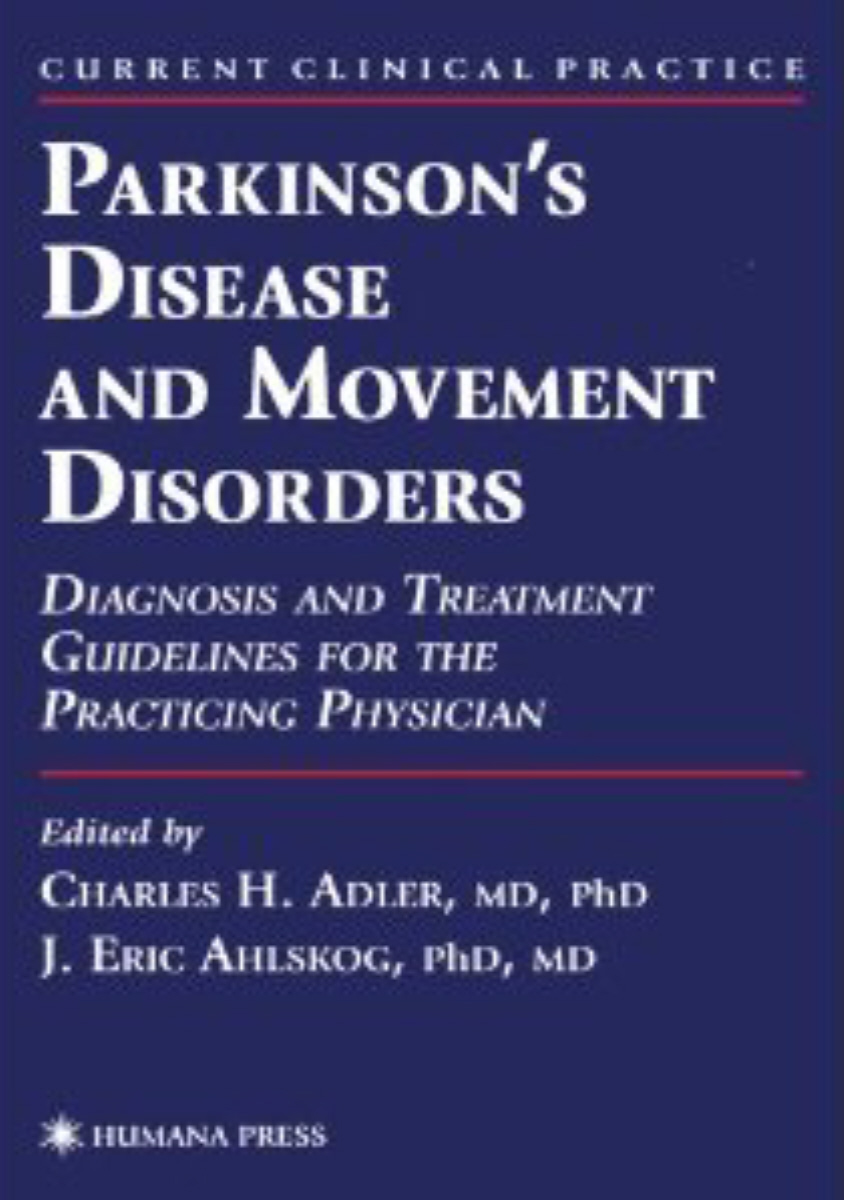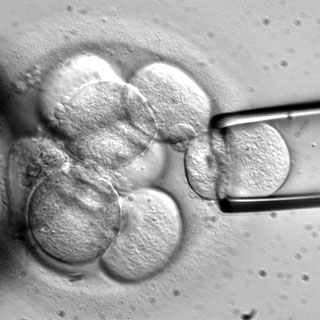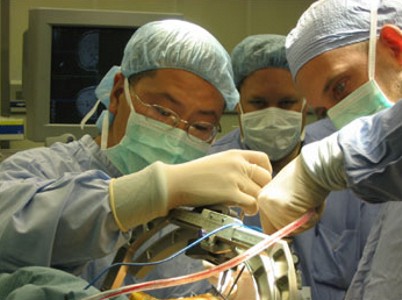|
JUNE
2010
�����������������������������������������������������������������������������������������������������������������������������������������������������
30th June 2010 - News release
MICROCHIPS TO CONTROL
PARKINSON'S DISEASE
A Tel Aviv University team is aiming to create a microchip that can help doctors
wire computer applications and sensors to the brain. Using Deep Brain
Stimulation to stimulate certain areas of the brain, the effects of medical
disorders such as Parkinson's Disease can be reduced. However, because
controlling that stimulation currently lacks precision, some of its therapeutic
benefits are lost over time. The team's method is to record activity using
electrodes
 implanted in diseased areas of the brain. Based on
an analysis of this activity, they develop algorithms
to simulate healthy neuronal activity which are programmed into a microchip and fed back into the brain. For now, the
chip, called the Rehabilitation Nano Chip (ReNaChip), is hooked up to tiny
electrodes which are implanted in the brain. But as chips become smaller, the
ReNaChip could be made small enough to be "etched" right onto the electrodes
themselves. For more information go to the complete
news release.
In order to refer to this
article on its own
click here. implanted in diseased areas of the brain. Based on
an analysis of this activity, they develop algorithms
to simulate healthy neuronal activity which are programmed into a microchip and fed back into the brain. For now, the
chip, called the Rehabilitation Nano Chip (ReNaChip), is hooked up to tiny
electrodes which are implanted in the brain. But as chips become smaller, the
ReNaChip could be made small enough to be "etched" right onto the electrodes
themselves. For more information go to the complete
news release.
In order to refer to this
article on its own
click here.
�
24th June 2010 - New research
THE CAUSE OF DEATH IN
PARKINSON'S DISEASE
Parkinsonism Related Disorders [2010] May 28. [Epub ahead of print] (Pennington
S, Snell K, Lee M, Walker R.)
Complete abstract
 The current literature provides little data
concerning the causes of death in Parkinson's Disease. Death certificate
documentation is inadequate in one third of certificates, making research
difficult. Less than two thirds of people with Parkinson's Disease actually had
Parkinson's Disease recorded on their death certificates. When thoroughly
assessed it was found that the most common cause of death in
people with Parkinson's Disease was Pneumonia, which was the cause of death in
45% of people. For more information concerning
Pneumonia. However, people with Parkinson's
Disease less likely to die of Cancer or Heart Disease than the
rest of the population.
In order to refer to this
article on its own
click here. The current literature provides little data
concerning the causes of death in Parkinson's Disease. Death certificate
documentation is inadequate in one third of certificates, making research
difficult. Less than two thirds of people with Parkinson's Disease actually had
Parkinson's Disease recorded on their death certificates. When thoroughly
assessed it was found that the most common cause of death in
people with Parkinson's Disease was Pneumonia, which was the cause of death in
45% of people. For more information concerning
Pneumonia. However, people with Parkinson's
Disease less likely to die of Cancer or Heart Disease than the
rest of the population.
In order to refer to this
article on its own
click here.
������������������������������������������������������������������������������������������������������������������������������������������������������������������������������
18th June 2010 - New research
TREMOR WRONGLY DIAGNOSED AS
PARKINSON'S DISEASE
Journal of Neurological� Neurosurgical
Psychiatry [2010] Jun 14 [Epub ahead of print] (N.P.Bajaj, V.Gontu, J.Birchall,
J.Patterson, D.G.Grosset, A.J.Lees)
Complete abstract
Tremor is often wrongly assumed to be Parkinson's Disease. This is despite
tremor occurring in a wide variety of medical disorders besides Parkinson's
Disease, and failing to occur in nearly a third of people who do have
Parkinson's Disease.� This contributes to a quarter of people diagnosed
with Parkinson's Disease being wrongly diagnosed, and consequently treated for a medical
disorder that they do not even have. This study examined the
 clinical accuracy of movement disorder specialists
in distinguishing tremor dominant Parkinson's Disease from other medical
disorders in which tremor occurred. As many as a quarter of those patients
assessed were diagnosed as having Parkinson's Disease when they did not even
have it.� As many as a fifth of the patients that did have Parkinson's
Disease were wrongly claimed not to have it.
This study demonstrated
the inadequacy of assessing Parkinson's Disease solely according to symptoms
instead of using biochemical means. In order to refer to this
article on its own
click here. clinical accuracy of movement disorder specialists
in distinguishing tremor dominant Parkinson's Disease from other medical
disorders in which tremor occurred. As many as a quarter of those patients
assessed were diagnosed as having Parkinson's Disease when they did not even
have it.� As many as a fifth of the patients that did have Parkinson's
Disease were wrongly claimed not to have it.
This study demonstrated
the inadequacy of assessing Parkinson's Disease solely according to symptoms
instead of using biochemical means. In order to refer to this
article on its own
click here.
�
15th June 2010 - New book
PARKINSON'S DISEASE AND MOVEMENT DISORDERS
Charles H.Adler, J.Eric Ahlskog (Editors)
 Publisher's
description : Highly experienced clinician-researchers distill the new
information now available about movement disorders to create a practice-oriented
tutorial for all physicians treating movement disorders. Their book helps
physicians distinguish each disorder, providing a basic understanding of both
the test and treatment options needed in active practices, as well as the
effective use of the therapeutic recommendations. The first half of the book is
devoted to Parkinson's disease and conditions masquerading as parkinsonism,
while the remainder details the recognition and treatment of tremor, dystonia,
chorea, myoclonus, tics, gait disorders, the ataxias, conditions resulting in
spasms, and restless legs syndrome. It provides sufficient background so that
even relatively inexperienced clinicians can master the diagnosis and
treatment.�
Click here for more details,
and for
the official web site. For
more books concerning Parkinson's Disease go to
Parkinson's Disease Books. Publisher's
description : Highly experienced clinician-researchers distill the new
information now available about movement disorders to create a practice-oriented
tutorial for all physicians treating movement disorders. Their book helps
physicians distinguish each disorder, providing a basic understanding of both
the test and treatment options needed in active practices, as well as the
effective use of the therapeutic recommendations. The first half of the book is
devoted to Parkinson's disease and conditions masquerading as parkinsonism,
while the remainder details the recognition and treatment of tremor, dystonia,
chorea, myoclonus, tics, gait disorders, the ataxias, conditions resulting in
spasms, and restless legs syndrome. It provides sufficient background so that
even relatively inexperienced clinicians can master the diagnosis and
treatment.�
Click here for more details,
and for
the official web site. For
more books concerning Parkinson's Disease go to
Parkinson's Disease Books.
�
10th June 2010 - New resource
A CLOSER LOOK AT STEM CELL
TREATMENTS
The International Society for Stem Cell Research
has published an online report that aims to educate those who might be tempted,
by providing criteria for people to evaluate claims made by clinics around the
world that offer stem cell treatments. For the full details go to
A closer look at stem cell treatments. The
International Society for
Stem Cell Research Society
is assessing stem cell clinics, and asking them to provide evidence in support
of their
claims of efficacy. Stem cell therapy clinics
can now be found in China, Central America, Russia, Europe and the
United
States.
 According to the head of Canada's Stem Cell Network "It's irresponsible and
despicable" that many
overseas clinics are purporting to offer stem cell treatments for people with
illnesses without any scientific
evidence". "Around the world, really the only proven treatments relating to stem
cells are for blood - using blood stem cells to treat various blood disorders,
predominantly various types of cancer - and some wound healing with some skin
treatments, and there's been some work done with the cornea," said Drew Lyall of
the Stem Cell Network. "If you go to the websites of many of these companies
you'll see that they're claiming to cure Parkinson's Disease and there's just no
scientific evidence for that."
For more information go to the complete
news report. According to the head of Canada's Stem Cell Network "It's irresponsible and
despicable" that many
overseas clinics are purporting to offer stem cell treatments for people with
illnesses without any scientific
evidence". "Around the world, really the only proven treatments relating to stem
cells are for blood - using blood stem cells to treat various blood disorders,
predominantly various types of cancer - and some wound healing with some skin
treatments, and there's been some work done with the cornea," said Drew Lyall of
the Stem Cell Network. "If you go to the websites of many of these companies
you'll see that they're claiming to cure Parkinson's Disease and there's just no
scientific evidence for that."
For more information go to the complete
news report.
It is often claimed that there is a massive loss of
the cells involved in Parkinson's Disease, and that stem cell therapy is
necessary in order to replace the lost cells. However, not a single study has
ever actually shown that there is massive cell loss in Parkinson's Disease.
In order to refer to this
article on its own
click here.
�
5th June 2010 - New research
DEEP BRAIN STIMULATION - A
COMPARISON OF THE TWO TYPES
New England Journal of Medicine [2010] 362 (22) :
2077-2091 (Follett KA, Weaver FM, Stern M, Hur K, Harris CL, Luo P, Marks WJ Jr,
Rothlind J, Sagher O, Moy C, Pahwa R, Burchiel K, Hogarth P, Lai EC, Duda JE,
Holloway K, Samii A, Horn S, Bronstein JM, Stoner G, Starr PA, Simpson R,
Baltuch G, De Salles A, Huang GD, Reda DJ) PMID: 20519680
�Complete abstract
Deep Brain Stimulation (DBS) is the main surgical procedure for people with
advanced Parkinson's Disease.
DBS involves the use of electrodes that are
implanted into the brain and connected to a small electrical device called a
pulse generator that can be externally programmed. For more information go to
Deep
brain stimulation. The globus pallidus interna and the
subthalamic nucleus are accepted targets for this procedure.
 Researchers
compared the outcomes for patients who had undergone these two types of DBS :
bilateral stimulation of the globus pallidus interna (pallidal stimulation), and
subthalamic nucleus (subthalamic stimulation). The average outcome did not
differ between the two methods. There was also no significant difference in
self-reported function. However, patients undergoing subthalamic stimulation :
required a lower dose of dopaminergic drugs than did those undergoing pallidal
stimulation, had slightly more serious adverse events than those undergoing
pallidal stimulation, and their depression worsened in contrast to an
improvement in people undergoing pallidal stimulation.
In order to refer to this
article on its own
click here. Researchers
compared the outcomes for patients who had undergone these two types of DBS :
bilateral stimulation of the globus pallidus interna (pallidal stimulation), and
subthalamic nucleus (subthalamic stimulation). The average outcome did not
differ between the two methods. There was also no significant difference in
self-reported function. However, patients undergoing subthalamic stimulation :
required a lower dose of dopaminergic drugs than did those undergoing pallidal
stimulation, had slightly more serious adverse events than those undergoing
pallidal stimulation, and their depression worsened in contrast to an
improvement in people undergoing pallidal stimulation.
In order to refer to this
article on its own
click here.
��������������
��
|
.gif)
.gif)



 Publisher's
description : Highly experienced clinician-researchers distill the new
information now available about movement disorders to create a practice-oriented
tutorial for all physicians treating movement disorders. Their book helps
physicians distinguish each disorder, providing a basic understanding of both
the test and treatment options needed in active practices, as well as the
effective use of the therapeutic recommendations. The first half of the book is
devoted to Parkinson's disease and conditions masquerading as parkinsonism,
while the remainder details the recognition and treatment of tremor, dystonia,
chorea, myoclonus, tics, gait disorders, the ataxias, conditions resulting in
spasms, and restless legs syndrome. It provides sufficient background so that
even relatively inexperienced clinicians can master the diagnosis and
treatment.�
Publisher's
description : Highly experienced clinician-researchers distill the new
information now available about movement disorders to create a practice-oriented
tutorial for all physicians treating movement disorders. Their book helps
physicians distinguish each disorder, providing a basic understanding of both
the test and treatment options needed in active practices, as well as the
effective use of the therapeutic recommendations. The first half of the book is
devoted to Parkinson's disease and conditions masquerading as parkinsonism,
while the remainder details the recognition and treatment of tremor, dystonia,
chorea, myoclonus, tics, gait disorders, the ataxias, conditions resulting in
spasms, and restless legs syndrome. It provides sufficient background so that
even relatively inexperienced clinicians can master the diagnosis and
treatment.�

 Researchers
compared the outcomes for patients who had undergone these two types of DBS :
bilateral stimulation of the globus pallidus interna (pallidal stimulation), and
subthalamic nucleus (subthalamic stimulation). The average outcome did not
differ between the two methods. There was also no significant difference in
self-reported function. However, patients undergoing subthalamic stimulation :
required a lower dose of dopaminergic drugs than did those undergoing pallidal
stimulation, had slightly more serious adverse events than those undergoing
pallidal stimulation, and their depression worsened in contrast to an
improvement in people undergoing pallidal stimulation.
In order to refer to this
article on its own
Researchers
compared the outcomes for patients who had undergone these two types of DBS :
bilateral stimulation of the globus pallidus interna (pallidal stimulation), and
subthalamic nucleus (subthalamic stimulation). The average outcome did not
differ between the two methods. There was also no significant difference in
self-reported function. However, patients undergoing subthalamic stimulation :
required a lower dose of dopaminergic drugs than did those undergoing pallidal
stimulation, had slightly more serious adverse events than those undergoing
pallidal stimulation, and their depression worsened in contrast to an
improvement in people undergoing pallidal stimulation.
In order to refer to this
article on its own